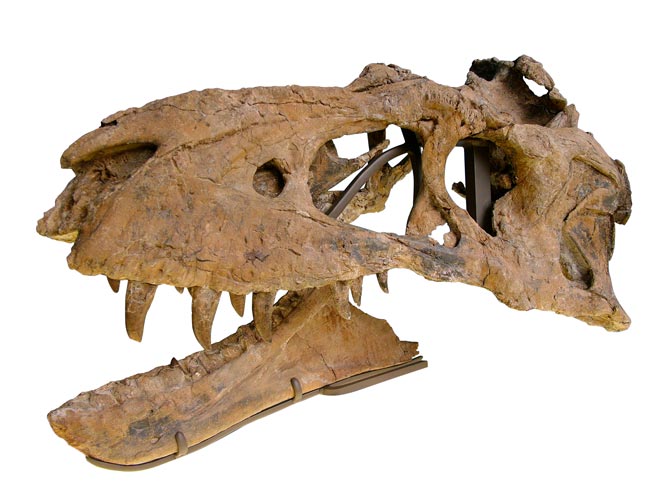New Tyrannosaur Species Discovered

T. rex's family tree just got one member larger. Scientists unearthed bones from a new dinosaur species, including an adult specimen and bones from a "teenager" that lived some 75 million years ago.
Called Bistahieversor sealeyi, the dinosaur lived about 10 million years before Tyrannosaurus rex appeared on the scene. Even so, B. sealeyi belongs to the same dinosaur linage as the famous T. rex.
Fossils from Bistahieversor (pronounced: bistah-he-ee-versor) were discovered in New Mexico back in 1998, and after many years of studying the bones, the paleontologists just announced the findings as a new genus and species, which they detail in the January issue of the Journal of Vertebrate Paleontology.
To the untrained eye, Bistahieversor looks like most of its tyrannosaur relatives, but many subtle features, especially in its skull, set it apart.
"When we take all these features together, it's clear that we have something different than what's been seen before," said Thomas Carr, a professor at Carthage College in Wisconsin, who studies tyrannosaurs and co-authored the paper.
The scientists based their conclusion on one main specimen, consisting of a complete adult skull and partial skeleton. This bipedal carnivore was about 29 feet (9 meters) long, with a head the size of a washing machine, and would have weighed at least a ton, Carr said. Bistahieversor was thus quite a bit smaller than its T. rex cousin, which had a head about 5 feet long and weighed around 6 tons, said Thomas Williamson, a curator of Paleontology at the New Mexico Museum of Natural History, who also was involved in the research.
The researchers also unearthed a "teenager" of the species, along with a few bones from another adult.
Sign up for the Live Science daily newsletter now
Get the world’s most fascinating discoveries delivered straight to your inbox.
Bistahieversor shares a few characteristics with more advanced tyrannosaurs, like the T. rex, but also has many, more primitive features. The findings give the researchers insight into the evolution of this dinosaur linage, helping them understand when particular features may have arisen.
"Our animal is a window on what that common ancestor might have looked like," said Carr.
Distinguishing features
Like T. rex, Bistahieversor had a deep snout (as seen vertically from the side), which would help the animal kill its prey using its jaws. The fact that Bistahieversor has a T.-rex-like snout, even though it is older, indicates that this feature is relatively primitive, Carr said, and it is not unique to more advanced tyrannosaurs.
More primitive tyrannosaurs were smaller, had shallow snouts and long forearms, and probably captured prey with their hands, Carr said. These creatures then increased in size, but still retained their shallow snouts. Later on however, their snouts increased in depth.
"Our new animal represents that change, after the large body size was established, then the snout became deep and the head became the main killing instrument," said Carr.
Unique predator
Finding this fossil in the American southwest "really changes our picture of what predators were around," Carr said.
Up until it was discovered, most of the teeth and bones found in the area were thought to be from dinosaurs that were more closely related to T. rex, such as Albertosaurus, and who lived farther north. But this fossil shows that there was actually a predator unique to the area.
And since Bistahieversor is more primitive than its northern cousins, "it seems that we have primitive animals hanging on in the southwest, but the advanced ones are farther north," said Carr, who added that he thinks this pattern was brought on by geographical barriers between the north and the south, such as the formation of the Rocky Mountains.
- Tiny Tyrannosaur Had Horns
- Oldest Known Tyrannosaur Found
- Image Gallery: Dinosaur Fossils

Rachael is a Live Science contributor, and was a former channel editor and senior writer for Live Science between 2010 and 2022. She has a master's degree in journalism from New York University's Science, Health and Environmental Reporting Program. She also holds a B.S. in molecular biology and an M.S. in biology from the University of California, San Diego. Her work has appeared in Scienceline, The Washington Post and Scientific American.










